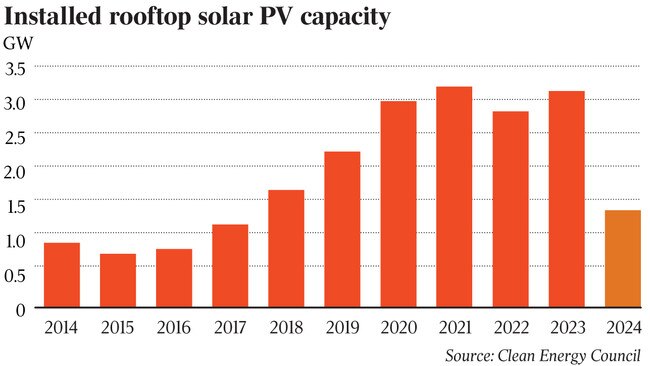Rooftop solar set to have larger capacity than coal by end of 2024
The projections from the Clean Energy Council will swell confidence that Australia can meet its 2030 energy transition targets, but it heightens concerns about inequality.

Australia’s rooftop solar capacity will be larger than that provided by coal by the end of 2024, new figures from the Clean Energy Council show — an outlook that will swell confidence the country can meet its lofty transition goals though it threatens to stoke so-called energy inequality.
The Clean Energy Council said approximately 1.3GW of rooftop solar capacity was installed by households and businesses during the first six months of 2024 and on current trajectory — Australia will pass 25GW of rooftop solar capacity by the end of the year.
Should that figure materialise, rooftop solar would be larger in capacity than black and brown coal capacity in Australia.
Clean Energy Council co-chief policy and impact officer, Con Hristodoulidis, said the result cements Australia’s position as a global leader.
“It’s become a staple investment for homeowners and small businesses. With typical payback periods of around three to four years, rooftop solar is now a recognised and simple step to take pressure off the family budget,” said Mr Hristodoulidis.
“Over 3.7m homes and small businesses now have solar panels on their roofs, helping them reduce their energy bills in the daytime.”

The result was a key driver in the outlook of the Clean Energy Regulator outlook which said Australia is on course to add 7GW, a result that the federal Labor government seized on as evidence it could meet its target of having renewable energy generate 82 per cent of the country’s electricity by 2030.
Australia must add about 7GW of wind and solar capacity each year, a feat that is widely believed to be extremely challenging amid scepticism from some rural communities towards large-scale projects or high voltage transmission lines.
But continued growth in rooftop solar will be a major boost. Increasing rooftop solar would not need new high voltage transmission lines, predominantly across rural regions — which insist their properties will be significantly up-ended and there is insufficient compensation.
Growth in rooftop solar will require upgrades to distribution lines but is unlikely to cause widespread disruption.
But while rooftop solar is increasingly popular as households seek to reap significant savings – it threatens to stoke inequality.
States and territories have dangled concessions — though the upfront costs of rooftop solar continues to be prohibitively expensive for many, particularly low income households.
Social advocates have warned that Australia’s energy transition could leave those most vulnerable paying the most for their electricity.
Australia’s fleet of coal power plants are all set to be retired by 2037, and there are concerns that the country will not be able to build enough alternatives quickly enough. If that occurs, Australian households face increased utility bills.
Higher income households will also have the capacity to invest in batteries, which will allow them to store excessive amounts of electricity produced by their solar panels. When the sun sets and the price of electricity rises, households with batteries will be able to run their homes on a battery – limiting their bills.
Batteries are even more expensive than solar panels, though proponents insist the price is falling and will accelerate in the coming years.
Mr Hristodoulidis said Australia must aid the falling cost of batteries.
“Incentives for home batteries are needed now to maximise Australia’s world-leading rooftop solar capacity,“ Mr Hristodoulidis said.
“It is a win-win outcome. In a midst of a slower economy, solar PV and home batteries can play a key role is lifting economic activity by support for thousands of Australian installers and businesses working in the sector, as well as lowering energy bills for all Australians.”
Increased batteries will also weaken Australia’s reliance on coal via so-called Virtual Power Plants (VPPs).
A VPP pools thousands of households or businesses with rooftop solar and batteries. Batteries are used to store excess energy generated through rooftop solar. But if a user is deemed to have sufficient energy in their battery, it could be discharged into the wholesale market when prices are high, offering them a financial return and helping to ease the squeeze on the grid.
While the uptake of batteries remains stunted by high prices, Origin Energy’s VPP is growing rapidly and it is now its biggest single unit generator of electricity.
Coal is the dominant source of Australia’s electricity network, providing about 60 per cent of the country’s power. Prolonging the use of coal would undermine Australia’s renewable energy target and scupper the country’s plan to be net zero by 2050.
More Coverage
Originally published as Rooftop solar set to have larger capacity than coal by end of 2024





